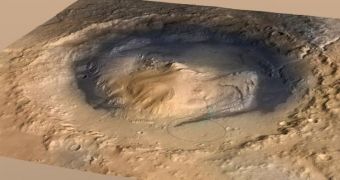The international, Mars Science Laboratory (MSL) Project Science Group announces that the central feature in the Gale Crater on the Red Planet has just been named Mount Sharp, in honor of planetary sciences founder Robert P. Sharp (1911-2004).
The expert helped educate a large number of the scientists currently leading this field of science, and the naming of a landscape feature on Mars after him is meant to recognize the influence he had in this regard, officials explain.
Sharp Mount is a mountain located right in the middle of Gale Crater, a massive impact basin that is the landing site for the 1-ton, Mini Cooper-sized MSL rover, Curiosity. The vehicle is scheduled to reach this location in August 2012.
Astronomers first discovered this peculiar mountain while conducting orbital observations of Mars in the 1970s. Measurements indicate that it raises about 5.5 kilometers (3.4 miles) above the northern crater floor, but only about 4.5 kilometers (2.8 miles) above the southern floor.
The reason Curiosity is being sent to this location is that the depth of the overall crater exposes numerous layers of rocks. Scientists are extremely curious to learn how the Martian climate evolved over time, and geological surveys are one of the best ways to go about doing that.
MSL's main mission is to determine whether the Red Planet was ever capable of supporting life as we know it. Theories say that it was once a world that featured liquid water on its surface, as well as an ocean, which means that life may have developed here as well.
Planetary scientists have been meaning to analyze Gale Crater for quite some time now, but the main issue was that landing technologies available until now were too imprecise, and incapable of landing a rover in the narrow gap separating the mountain's slopes from the crater rim encircling it.
“We don't really know the origins of Mount Sharp, but we have plans for how to go there and test our theories about it, and that's just how Bob would have wanted it,” explains Michael Malin, from the San Diego-based Malin Space Science Systems (MSSS).
The expert holds an appointment as the principal investigator for 2 out of 10 scientific instruments on the NASA rover, and was one of Sharp's students. The MSL mission is managed by the Jet Propulsion Laboratory (JPL), a division of the California Institute of Technology (Caltech), in Pasadena.
“Mount Sharp is the only place we can currently access on Mars where we can investigate this transition in one stratigraphic sequence,” Caltech MSL chief scientist John Grotzinger explains.
“The hope of this mission is to find evidence of a habitable environment; the promise is to get the story of an important environmental breakpoint in the deep history of the planet. This transition likely occurred billions of years ago – maybe even predating the oldest well-preserved rocks on Earth,” he concludes.

 14 DAY TRIAL //
14 DAY TRIAL //